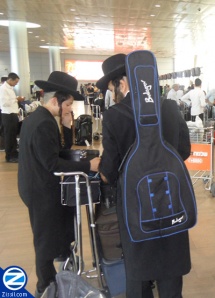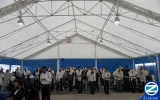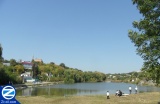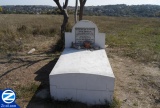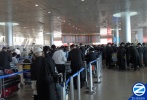Uman Rosh Hashana
Uman Rosh Hashanah is an annual pilgrimage of the Breslov Chasidim to the grave of their founder, Rebbe Nachman in Uman, Ukraine during the Jewish holiday of Rosh Hashanah. Originally the gathering took place during the life of Rebbe Nachman and was later continued by his student Rebbe Nasson after his masters death. In recent years an average of 40,000 Jews attend the gathering each Rosh Hashana.
[edit] Rebbe Nachman
Rabbi Nachman (1772 - 1810) was the great grandson of the Baal Shem Tov and founder of the Breslov movement. His followers consider him the spiritual leader for all onward generations until the arrival of the Mashiach. He left over many inspirational teachings and practically applicable advice, written by himself or transcribed by his main student Rabbi Natan. He passed away at the age of 38 and was buried in Uman as he requested.
Although the Breslov movement was relatively small for its first 150 years, it has greatly spread across the globe over the last two decades, greatly due to the efforts of the Na Nach. Tens of thousands of Jews consider themselves followers of Rebbe Nachman and many others greatly respect him and his teachings despite continuous affiliation with their previous groups. Millions of Breslov books can be found throughout every type of Jewish household.
[edit] Tikkun Haklali
One of Rabbi Nachman's main accomplishments was the revelation of the Tikkun Haklali. The Tikkun Haklali is a list of ten chapters of Tehilim that are a great rectification for the damage caused by nocturnal emissions when recited consecutively. Reciting the Tikkun Klali also rectifies all other sins, especially sexual ones. The chapters of the Tikkun Klali are 16, 32, 41, 42, 59, 77, 90, 105, 137, 150. Tikkun Klai can be recited even with little of no concentration although it is preferable. If one can, he should go to the Mikva that day before reciting the Tikkun HaKlali. Some people also recite the appended prayers from Rebbe Nasson at the end of the Tikkun Klali.
[edit] The Promise
Rabbi Nachman made a vow in front of two of his students, Rabbi Aharon of Breslov and Rabbi Naftali of Nemirov, after appointing them as witnesses, that any person that would come to his grave, gave a preutah to charity in his merit and recited the Tikkun Haklali, he would try hard through great length and breadth to save and rectify this person, even if his previous sins are very great and severe. He also said he would drag the person out of the lower realms of hell by his Peyous. Such a promise has never been made by any other Tzadik, causing many people to fulfill its conditions.
[edit] The Rosh Hashana Kibutz
- - -
While reciting the Tikkun Haklali at Rebbe Nachman's kever to fulfill the conditions of his promise can be done any time during the year, many prefer to do it on Erev Rosh Hashana.
[edit] Shticha on Kever
[edit] Children before Age Seven
Rebbe Nachman also said that any child that comes to his grave, gives the charity and recites the Tikkun Haklali before the age of seven, will receive protection from nocturnal emissions until he gets married. It is obvious however that this child can not defile himself willingly with impurity as he grows up although the promise will regardless help him to a degree.
[edit] Uman Uman Rosh Hashanah
Each year thousands of Jews from every walk of life visit Uman for the Rosh Hashana gathering. Some are hardcore devotees others hardly know anything about Rebbe Nachman. Some people come for Rebbe Nachman's promise of rectifications, others come for miracles or spiritual light, still others come solely for the great Uman adventure. Some people, especially the Nanachs claim that a lot of external agendas, unrelated to Rebbe Nachman have worked their way into the Uman gathering in recent years but can be looked at as just another obstacle to reaching the Tzadik.
[edit] Demographics
In recent years the number of visitors range between 30,000 - 40,000. Most visitors originate from Israel but many come from other countries. Aside from Breslov Chasidim, there many people from other Chasidus and Orthodox groups that come each year since they respect Rebbe Nachman and his teaching. There are also many non religious secular people that come year after year to the gathering. Each year many new people arrive in Uman, some come back the following year, while others are content with their one time visit. Very few women come to Uman on Rosh Hashana and all the Breslov Rabbi issued a ruling forbidding women from coming at that time of the year.
[edit] Light and Spirituality
[edit] Miracles
Many people claim to have seen personal miracles and salvation due to their visit to the grave of Rabbi Nachman. Rabbi Nachman also stated that was 'The Matchmaker' and many attribute their marriages to his merit.
[edit] Spiritual Preparations
Many people take on some spiritual commitments or make some preparations before visiting the Kever of Rebbe Nachman for their rectification. Breslov tradition teaches that Rabbi Nachman will work with those that have issues with jealousy and immoral lusts but those that come with haughtiness, honor and mockery will be rejected.
[edit] Tickets and Flights
Many people try to take advantage of the visitors to the Rosh Hashana gathering and ticket prices from Israel to Ukraine jump from an average $300 to $750 - $1100 in the days surrounding Rosh Hashana. Prices from other countries do not vary much since there is not enough of an influx. Tickets from the USA average around $1100. While travel agents definitely get a nice cut of the overpriced tickets, the airlines themselves also get a fair share of the blame. Some insiders claim that the prices are bumped up since they know Breslov Chasidim will be forced to pay them regardless, they also claim the airlines hold the market in a mafia like grip along with the Ukrainian government, preventing any new players from entering. It must also be taken into consideration that some of the plains travel back emptier in one of the directions, since all the traffic is focused one way. Most visitors arrive a day or two before Rosh Hashana and leave within the same period of time after the holiday. There are those that arrive earlier and remain until after Yom Kipor or the third day of Chal Hamoed Sukkot, the Hillula of Rabbi Nachman. Those that stay for longer then the standard amount of time save on their airfare.
[edit] Charters vs. Set Flights
Often the leading travel agencies book charter flights where they control all the seats. These charter flights are often cheaper then set flights but are less reliable, they often are more likely to be subject to delays and mistreatment. Additionally travelers using charter flights do not return via the regular terminals in Odessa and Kiev, instead they are forced to use makeshift tent terminal in back of these airports. There they are often made to wait for long periods in the freezing cold and are subject to much mistreatment. Some chasidim prefer to use the charter flights since they do not allow women on them and make it easier for them to guard their eyes from immodesty.[edit] Airports
Kiev and Odessa are the two main airports used to travel to Uman, both are 3.5 to 4 hours away. Recently flights started arriving in the new Vinnitsa, which is only 2 hours away, and are increasing by the year. Transportation from the airports to Uman is either via private Ukrainian drivers or through vans, organized by Uman Express and Euro Pnim. In early years most visitors who could not afford the private taxis would travel in large buses organized by the travel agencies. Use of buses has greatly decreased since the innovation of the faster and more efficient vans.[edit] Free and Discounted Tickets
For a few years free tickets were given out to individuals that had never yet been to Uman, this project costing in the millions was led by Yisroel Zinger. This endeavor did not last long term and ended after 3-4 years. Nachali Aytanim, the Shuvu Banim agency tried offering subsidized tickets but when they failed to raise enough funds they were forced to cancel the promotion and refund the money.
[edit] Travel Agencies
There are a number of companies that have formed over the years to monetize the Uman pilgrimage.
[edit] Derech Tzadikim
Run by the Gabbi family, also does cross country tours to various Kivray Tzadikim in Ukraine and Europe in general, an industry they helped create through their Ohali Tzadikim organization.
[edit] Revivos - Kanfi Nesharim
Kanfi Nesharim recently changed their name to Revivos.
[edit] Nachali Eytanim
Nachlay Atanim is run by Shuvu Banim, sometimes they offer discounted and subsidized tickets but are not reliable and sometimes cancel a little before Rosh Hashana.
[edit] Dovid Bergman
[edit] Nesia Travel
[edit] Self Booked Tickets
Some people prefer to avoid the Charadi travel agencies and prefer to book tickets via the internet or regular travel agents. This opens up many more options including stopovers in Egypt, Poland, Romania and Turkey which and drastically lower the overpriced fares.
[edit] Visas
For years travelers from Israel had to pay an extra visa fee to the Ukrainian government, while visitors from other countries such as the USA were exempt. Due to negotiations between Israel and the Ukraine the visa fee was abolished and in recent years it no longer had to be paid.
[edit] Schedule
There is no set schedule in Uman and no one enforcing it. There is however a rough routine that has developed based on Breslov customs, Halacha, initiations of the Uman committees and practices that developed over the years. Hisbodedute, trying to reach the Tziyun and studying the books or Rebbe Nachman are done throughout.
[edit] Zechor Bris
Erev Rosh Hashana has longer Selichot then any other day, referred to as Zechor Bris, which can take 2-3 hours to recite. While there are many other smaller minyonim for Slichas, a very large one take place at the Kloyize in the wee hours of the morning.
[edit] Erev Rosh Hashana
Erev Rosh Hashana is a busy day especially for people that just arrived, aside from all preparations needed for the holiday, one has to make time for visiting the Tziyun, reciting Tikkun Haklali, doing Viduy Devarim and going to the Mikva. According to Halacha one is supposed to fast until Chatzot on Erev Rosh Hashana.
[edit] Tikkun Klali
One of the main reasons of coming to Uman for Rosh Hashana is to recite the Tikkun Klali by the Tziyiun on Erev Rosh Hashana. Practically everyone arrives at the Tziyun at some point during the day to give the customary coin for Tzeduka in merit of Rebbe Nachman and to recite the Tikkun Klali and often the following prayer from Rebbe Nasson. Around Chatzot (Mid day) there is a massive group recital of the Tikkun Klali that is broadcast to a number of locations throughout the world.
[edit] Viduy Devarim
The concept of Viduty Devarim - Confession of sins in front of a Tzadik is very stressed in the Breslev teachings and was practiced by Rabbi Nachman and his followers for a certain period of time. Most people agree that nowadays it can not be done in front of a live rabbi but only silently at the Kever of a big Tzadik. While Vidoy Devarim can be done any time, it customary to do so at Rebbe Nachman's tziyun on Erev Rosh Hashana. Some people choose to confess their sins in their own words. Others who find it hard to organize their thoughts and words tend to use the abridged vidoy composed by Rabbi Yitzchok Briter along with the viduy of Rabbi Nissim Gaon. In recent years the Nanachs have published an expanded confession manual based on the many teaching of Rabbi Nachman and his students.
[edit] Buying A Knife
In Sefer Hamidos it brings down that it is a Segulah for wealth to buy a knife on Erev Rosh Hashana. There are a number of men that pedal knives on the streets near the Tziyun. Part of the Segula involves sharpening the knife and reciting "Hachotech Chayim Lkol Chi" - "He who cuts life to all the living". Most knives sellers offer a knife sharpener allowing their buyers to sharpen their knives. Some people try to immerse their knives in the mikva before Yom Tov.
[edit] Pidyon Nefesh
[edit] Haircuts
It is customary to get a haircut on Erev Rosh Hashana and many people choose to get their head shaven, leaving only the beard and payius.
[edit] Mikvah
Most visitors to Uman are daily Mikva users, however even those that are not will immerse on Erev Rosh Hashana. Most people immerse in the main Uman mikvah or in one of the smaller one but some people prefer to immerse in the local lake or river since they offer a higher level of purity.
[edit] Hataras Nidarim
It is customary according to halacha to absolve vows on Erev Rosh Hashana, this is done in front of any three people, normally right after Shachris or throughout the day. Those that miss it have up to Yom Kippor to make it up.
[edit] First Night
[edit] First Day
[edit] Tashlich
After Mincha on the first day, throngs of people head down to the lake at the bottom of the hill to do Tashlich. There is much unity and happiness during Tashlich with a lot of singing and dancing. This is the only point during the Uman gathering where practically everyone gets together in a single location during a period of two hours. During the Holocaust local Ukrainians drowned hundreds of Jews in the this lake and this massive Tashlich is considered a great rectification for their souls.[edit] Second Night
[edit] Second Day
[edit] Shabbosim
[edit] Motzay Yom Tov
[edit] Tzom Gidalya
[edit] Shiurim
The Uman Committee normally organizes different Shiurim given in various locations by various Rabbis at different times throughout the Uman stay. Most Shiurim are in Hebrew but some are given in English by American rabbis. Some Breslovers such as the Na Nach disagree with this concept.
[edit] Accommodations
[edit] Sleeping
[edit] Local Apartments
[edit] Zinger's Tents
[edit] Hotels
Some people have opened mini hotels these include Landue, Uman Experience and Ark 18.
[edit] Camping Tents
Some people can not afford to pay for sleeping accommodations, having already overspent for the tickets. They bring and set up camping tents is a number of locations where that option exists. One of the main locations is in the hill under the Tziyun. When considering camping tents one should be aware that weather in Uman around Rosh Hashana is generally freezing cold and rain is common.
[edit] Purchased Apartments
[edit] Villas
[edit] Mikvaot
[edit] Watching Items
[edit] Food and Meals
There are a number of Kosher restaurants in Uman. Some are open only around Rosh Hashana and other are open all year long. These include 'The Royal Oasis' a Glatt Kosher Mehadrin full service meat restaurant and the 'Bean of Hope Cafe' a Cholov Yisrael dairy restaurant. These two are open all year round and are run by the Ark 18 hotel.
[edit] Louie Scheiner
A business man from Monsey NY, that gives out free food in Uman. In recent year he created huge tents that also provide the holiday meals at discounted prices. Tickets are sold which are then presented to the guards for admittance on the holiday.
[edit] Shatnez
It is common for garments purchased in the local market to contain Shatnez, a mixture of wool and linen. This is especially true with the Russian style fur hats that are commonly purchased. In order to deal with this, a small Shatnaz laboratory was set up in the courtyard of the Kloyze, where people can submit items for Shatnez testing and pick them up a few hours later.
[edit] Booths
Practically every Breslov organization and publisher sets up booths in Uman to fundraiser money or sell their publications. Most notable is the booth of Keren Rabbi Yisroel Ber Odesser in the main square. There are also a number of unrelated booths selling other items. Each year the locations and the regulations involving setting up boots varies.
[edit] Local Market
Each year the locals set up booths to peddle their trinkets and objects. Some Hasidim warn against visiting these booths to avoid being exposed to immodesty.
[edit] Minyanim
There are dozens of minyanim on Rosh Hashana in the area surrounding the Tziyun and the proceeding streets.
[edit] Around Tziyun
There is a large Sefardic minyon in the outside section of the Tziyun. In the inside there is a Yeminite minyan. Behind the Tziyun is the Minyan of the Nanach's who follow the path of Rabbi Yisroel Ber Odesser. In the side rooms is the lengthy minyan of Rabbi Yitzchock Meir Morgenstern and his followers and some other Sephardic minyanim. The entrance of the Tziyun serves like a shtible with 2-3 minyanim taking place at a time with new ones starting as the old ones end. In the block surrounding the Tziyun as well as the main square many small minyonim take place, mostly in Nusach Edut Hamizrach.
[edit] The Kloze
The Kloze was built by the various Breslov communities that existed throughout the past decade. It was created to emulate the original Kloze that was built by Rebbe Nasson and contained the Rosh Hashanah prayers during his life and proceeding years. The Kluyze contains two large Shuls. On the first floor is the large Sefardik minyon. On the secound floor is the large Ashkanazi minyon, where most of the traditional Breslovers pray, as well as Rabbi Koenig, Rabbi Berland, Rabbi Arush and their followers. This section contains two large balconies where younger Yeshiva students sit. All seats in the Kloyze are sold. Prices in the Ashkanazi minyon range much higher then the Sephardic minyan, sometimes in the hundreds of dollars for prime locations. Many people have established rights to certain seats, having purchased this for thousands of dollars. Prayers in the Ashkanazic section are drawn out with a lot of singing by the Chazan and end late. In the earlier years of the Uman gathering, everyone would pray at the Kloyze. Rabbi Yisroel Odesser was the first to officially break away, establishing a Nanach minyan with his followers.
[edit] The Metetroton
The Metetroton is a large store house a little down the road from the Tziyun. It initially served as a lunch room where many of the people ate their meals. It was later taken over by Rabbi Elizer Shick and his Chasidim who established a minyan there.
[edit] Other Minyonim
Most Rabbis that do not pray in the Kloyze make minyonim with their followers in various locations. Other groups make minyonim as well, sometimes in the area they rented out for the week. There is also a Chabad minyan in back of the abandoned Shari Tziyun hotel.
[edit] Breslov Niggunim
Breslov has its own unique tunes for many section of the High Holiday prayers, these are sung in most of the Ashkanazic minyanim in Uman. Sephardic minyanim tend to use their traditional tunes associated with that groups particular origins.
[edit] Singing
Much singing and dancing that takes place in the Uman minyanim. It is very common for singing to suddenly start and last for up to an hour. Most songs sung are traditional Breslover as well as recently developed Uman songs. In certain minyonim they occasionally break into chants of Na Nach Nachma Nachman Meuman.
[edit] Kohanim
There is a long on going debate of whether Cohanim are allowed to visit the graves of Tzadikim since they do not carry impurity. Some people say it is permitted, others say it is a Biblical transgression for Kohanim to do so. This is further complicated in situation like the Kever of Rebbe Nachman that is located in middle of a cemetery, surrounded by many other graves of which many are not Tzadikim. Yet there were many Kohanim that still would visit the Tziyon itself, causing controversy.Initially a small ramp was built for kohanim which led to a small room in back of the Tziyun using Halachic technology to prevent the transfer of impurity, this allowed Kohanim to get relatively close to the Tziyon with out any worries. Recently the old ramp was removed allowing for the expansion of the Nanach minyan behind the Tziyun. In its place a large bridge was built from the entrants of the Gabbi Mikvah to center of the outside half of the Tziyun. A large split was then created in the roof of the outside part of the Tziyun running across its entire length, Halachicly separating 80% of the room and making it permissible for use by Cohanim.
[edit] Committees
[edit] The Vaad
[edit] Breslov World Center
[edit] Bais Tziyun Rabbanue
[edit] Tznius Patrol
[edit] Mefursamim
[edit] History of the Uman Gathering
[edit] Relationship With Locals
[edit] Kivrei Tzadikim
Many visitor to Uman often try to visit other Kivrei Tzadikim during their trip to the Ukraine. Locally they visit the Kevraim of Rabbi Shimshon Barskey and Rabbi Avraham Chazan. Often visitors will travel to Rebbe Nasson, the Baal Shem Tov, Rabbi Levi Yitzchok of Berditchev and return to Uman, a route that takes 18 hours. Some visitors will only go to part of the three or do it on their way to or from the Kiev or Vinnitsa airports to save time.
[edit] New Jewish Cemetery
The entire area around the Rebbe Nachman's Kever is the 'Old Cemetery'. On the bottom of the hill a little past the lake on the right side of the road is the 'New Jewish Cemetery'. This cemetery was almost completely razed during WWII and the following communist reign. It now appears like an empty field. Based on the testimonies of elderly locals the approximate locations of the graves of Rabbi Shimshon Barsky and Rabbi Avraham ben Nachman Chazan were established and Matzavous were erected. Also buried in this cemetery are Rabbi Elyakim Getzel, Rabbi Naftali a main disciple of Rebbe Nachman, Rabbi Nachman Chaylus a grandson of Rabbi Nachman, Rabbi Yosef Yonah the youngest son of Rebbe Nasson and Rabbi Nachman Tulshiner one of Rebbe Nasson's main students. A memorial was also built for the 3,000 Jews that were murdered by locals during 1919 and buried in the cemetery in a mass grave.[edit] House of Rebbe Nachman
Also visited is the house where Rabbi Nachman passed away, which is still standing in its original condition.
[edit] Breslev
Rebbe Nasson of Nimirov is buried in the city of Breslov which is around and hour and a half away from Uman.
[edit] Mezibuz
Rabbi Yisroel Baal Shem Tov is buried in Mezibuz around 3 hours away from Uman along with his grandchildren and other tzadikim. Visitors to Mezibuz often stop by in the old Bais Medrash of the Baal Shem Tov as well.
[edit] Berditchev
Kever Rabbi Levi Yitzchok of Berditchev is located around 3 hours away from Uman.
[edit] Other Kevarim
There are dozens of other kevray tazadikim and Jewish cemeteries throughout Ukrainian. Ohalei Tzadikim, an organization run by Yisroel Meir Gabbai attempts to prevent the destruction and maintain upkeep of these locations. They publish a book and map with the location of these various kevarim.
- Uman Rosh Hashana Photo Gallery


